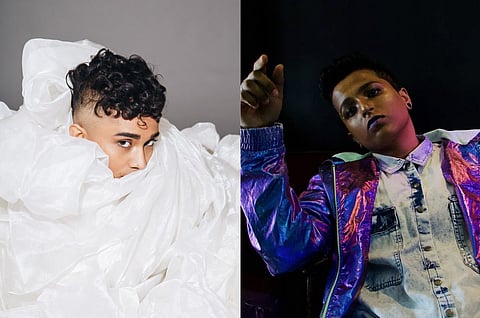
- HOMEGROWN WORLD
- #HGCREATORS
- #HGEXPLORE
- #HGVOICES
- #HGSHOP
- CAREERS
- ABOUT US
- CONTACT US

Shakti, a dual incarnation of masculine and feminine powers in Hindu mythology are considered to be the two aspects of the same reality. Their mutual presence is at the core of our ancient texts and this union is observed as the basis for all creation. India’s first performing drag king, Durga Gawde embodies the role of Shakti to translate their everyday experiences into a lyrical work of art. The sculptor and artist has one of the most impactful voices in the community and is taking the concept of fluidity to the masses.
While drag culture in India is often misunderstood as a western concept, in reality South Asia’s rich heritage is intertwined with performance and fluid identity. This is why Indian drag kings today are becoming the faces of the movement, as their performative identity is not a superficial character but rather an extension of their own reality. Blurring the lines between the binaries, performers such as Durga are making masculinity more intimate, personal and experimental.
Similarly, Bidisha Mohanta a young queer individual who goes by the stage name Badshah is popularising the historically marginalised subculture of drag kings. According to Verve, the assumed standard of socialised masculine behaviour in India can be less theatrical in compassion to feminine behaviour. Which is why drag kings are relatively less popular than famous drag queens, however Bidisha changes this narrative by emulating a form of grandiose masculinity.
Further sharing their thoughts with journalist Radhika Iyengar, Mohanta explains how this celebration of Badshah gives means to the defiance of a singular narrative, as this persona can be utilised to destabilise an accepted ‘normal’. The desi drag king shares how they feel liberated and empowered through the act of performance on stage and how the same can be true for so many other queer individuals eager to explore their multi-layered identities.
In order to create a bolder representation of the drag king subculture, The Gentleman’s Club AKA Tape by The Patchworks Ensemble is utilising cabaret-style performance to imagine Mumbai through the lens of a roaring drag king scene. Weaving an exciting and provocative tale of women and their celebration of masculinity, it revels in the ability to respond creatively to misogyny in daily life and behave in ways that would otherwise not be acceptable in our society.
Puja Sarup who plays the role of a drag king in the narrative gave birth to The Gentlemen's Club by exploring masculinity as a medium of art where they re-examine world views. The play has received an overwhelming response in cities like Guwahati and Lucknow as well, as it is an exploration of an alternate reality where curiosity makes us wonder of a world where drag kings are common. It provides depth and meaning to the experience while pushing boundaries of gender in performative spaces.
The theatrical styles of Indian drag kings are making room for a more brazen experimentation for all. As they evoke a sense of cultural empowerment by capturing different elements of masculinity. These performances are also small movements that utilise the vast accounts of gender fluidity that are already abundant in our mythology. It is the stage where drag kings become one with their inner identity and through performance take the message of gender fluidity forward.
